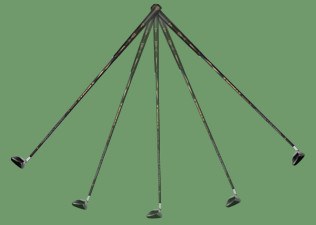
In golf, “club swingweight” refers to the measure of a golf club's balance and feel during the swinging motion. It indicates the distribution of weight throughout the clubhead and shaft and is expressed as a letter and a number, such as D2 or C7. Club swingweight is an important factor in club fitting and can influence a golfer's swing tempo, control, and overall feel of the club.
Here are a few key points about club swingweight:
- Measurement: Club swingweight is measured using a swingweight scale. The scale assigns a numerical value to represent the balance point of the club. The higher the swingweight number, the heavier the clubhead relative to the grip end, resulting in a higher swingweight.
- Balance and Feel: Club swingweight affects the balance and feel of the club during the swing. A higher swingweight indicates a club with more weight in the clubhead, which can provide a sense of heft and stability during the swing. Conversely, a lower swingweight suggests a lighter clubhead, which can promote a lighter feel and potentially faster swing speed.
- Swing Tempo and Control: Club swingweight can influence a golfer's swing tempo and control. A heavier swingweight can encourage a smoother and more deliberate swing, potentially promoting better rhythm and control. Conversely, a lighter swingweight may allow for a quicker swing tempo and increased maneuverability, but it can also lead to less stability and control for some golfers.
- Personal Preference and Custom Fitting: Club swingweight is a personal preference that can vary among golfers. Some golfers prefer a heavier swingweight for a more solid and controlled feel, while others may prefer a lighter swingweight for enhanced maneuverability and feel. Custom club fitting takes into account a golfer's swing characteristics, strength, and preferences to determine the appropriate swingweight for each individual.
- Adjusting Swingweight: Swingweight can be adjusted by adding or removing weight to the clubhead or grip end. Adding weight to the clubhead increases the swingweight, while adding weight to the grip end decreases it. Adjusting swingweight can be done through the use of lead tape, weighted inserts, or custom club fitting.
Understanding club swingweight can help golfers find clubs that match their swing characteristics and provide the desired feel and control. Consulting with a professional club fitter or golf instructor can assist in determining the appropriate swingweight based on a golfer's individual needs and preferences.
A club's weight distribution relative to a fixed fulcrum point, typically 14 inches from the butt (grip end) of the club. Swingweight is measured in alpha-numeric units such as D-1, D-2. The letters used are A through G, with numerals from 0-9 (up to 10 for G).
The higher a club’s letter-number unit, the closer its balance point is to the head, and the heavier it will feel when swung. The lightest possible swingweight is A-0; the heaviest is G-10. For men, the standard swingweights are D-0 and D-1; for women, C-5 to C-7.
Swingweight is not the same as a club’s total weight, measured in grams.





